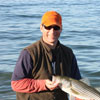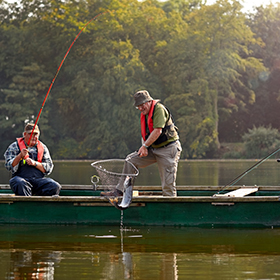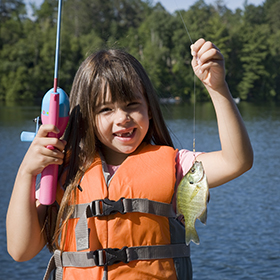In the early season, there isn’t much of a reason to get up at the crack of dawn to go trout fishing. The water is cold and the fish are lethargic
In the early season, there isn’t much of a reason to get up at the crack of dawn to go trout fishing. The water is cold and the fish are lethargic. Head out for some pancakes and let the sun warm things up for a bit. And here are a few things to remember when you go down to the river. Riffle at the top, run in the middle.
Trout are coldwater species, so use a thermometer to take the water temperature. If the water is between 55-65 degrees a trout will process one stomach of food every day. When the water temperature is below or above that range it’ll process a stomach of food every four days. You’ll want to be on the water when the temps are between 55-65 for sure, for that’s when they’ll hit the most.
Trout are opportunistic feeders and that means they want to take in more calories than they burn off. They’ll sit in slow water so they don’t have to swim hard and then move into faster water to intercept an insect or a baitfish.
While there are a lot of different types of water, the basics are riffles, runs, pools, and pockets.
A riffle is shallow with lots of underwater rocks and cobble. The current is relatively quick.
A run is moderately deep with a normal current speed and is a mix of sand and rock.
A pool is deeper and has a slow current speed and usually a soft bottom.
Pocket water is full of boulders that are exposed, and those offer perfect holding water for trout.
Water levels are important, for as the air temperatures rise the snow will melt. Heavy water pushes fish into deeper water like a pool or a run while slower water enables them to move into the riffles to feed.
Feeder streams that dump into a main branch are smaller and shallower. If your main river is running high, head into a feeder stream to look for fish.
Worms and night crawlers are good in pools. Shiners and other baitfish are good in runs. Spinners or spoons are good choices in riffles, runs, and pools. Use a faster retrieve in a riffle and a slower retrieve in a run or a pool. Flies are good choices in each and excel in pocketwater.
As blogger Andy Whitcomb discussed in his post, a pair of polarized glasses are invaluable for spotting fish.
The fish are where you find them, and to catch them you’ll want your fly, lure or bait to be where the fish are. If the water is heavy they’ll be deep. So, add a split shot. If the water is normal and they’re in the middle, fish without weight.
Trout are coldwater species, so use a thermometer to take the water temperature. If the water is between 55-65 degrees a trout will process one stomach of food every day. When the water temperature is below or above that range it’ll process a stomach of food every four days. You’ll want to be on the water when the temps are between 55-65 for sure, for that’s when they’ll hit the most.
Trout are opportunistic feeders and that means they want to take in more calories than they burn off. They’ll sit in slow water so they don’t have to swim hard and then move into faster water to intercept an insect or a baitfish.
While there are a lot of different types of water, the basics are riffles, runs, pools, and pockets.
A riffle is shallow with lots of underwater rocks and cobble. The current is relatively quick.
A run is moderately deep with a normal current speed and is a mix of sand and rock.
A pool is deeper and has a slow current speed and usually a soft bottom.
Pocket water is full of boulders that are exposed, and those offer perfect holding water for trout.
Water levels are important, for as the air temperatures rise the snow will melt. Heavy water pushes fish into deeper water like a pool or a run while slower water enables them to move into the riffles to feed.
Feeder streams that dump into a main branch are smaller and shallower. If your main river is running high, head into a feeder stream to look for fish.
Worms and night crawlers are good in pools. Shiners and other baitfish are good in runs. Spinners or spoons are good choices in riffles, runs, and pools. Use a faster retrieve in a riffle and a slower retrieve in a run or a pool. Flies are good choices in each and excel in pocketwater.
As blogger Andy Whitcomb discussed in his post, a pair of polarized glasses are invaluable for spotting fish.
The fish are where you find them, and to catch them you’ll want your fly, lure or bait to be where the fish are. If the water is heavy they’ll be deep. So, add a split shot. If the water is normal and they’re in the middle, fish without weight.









